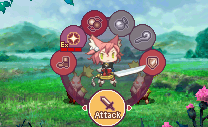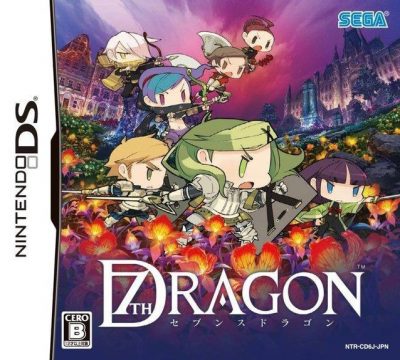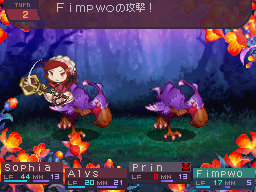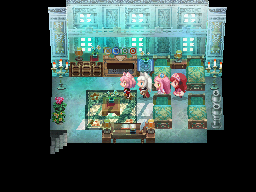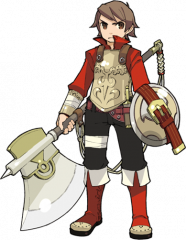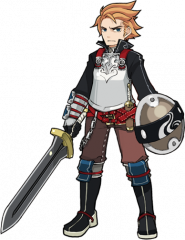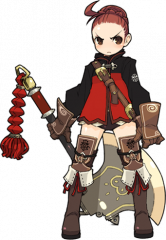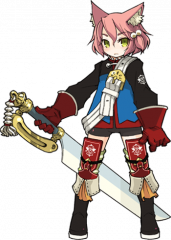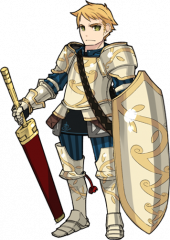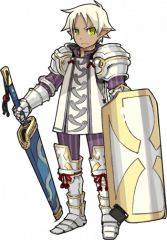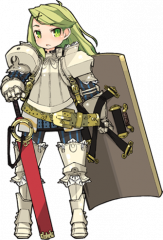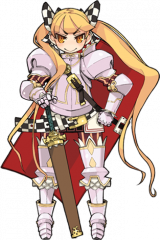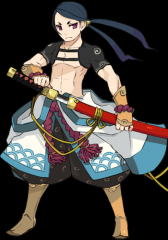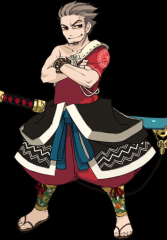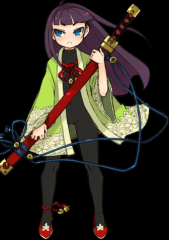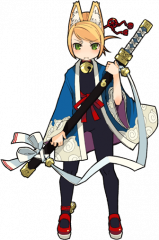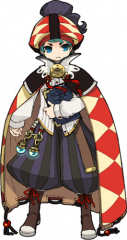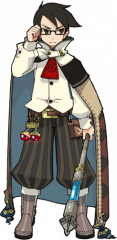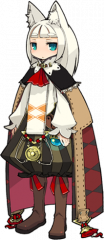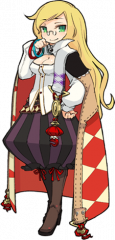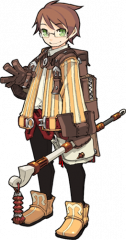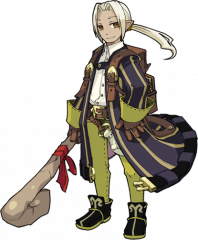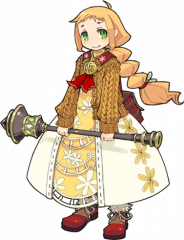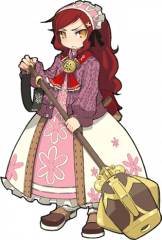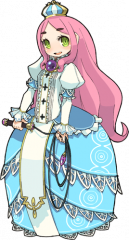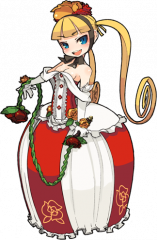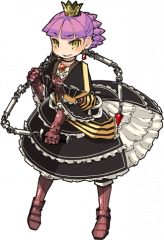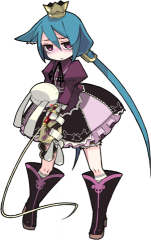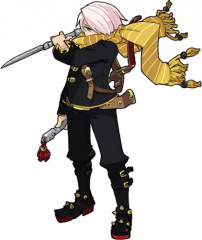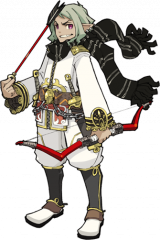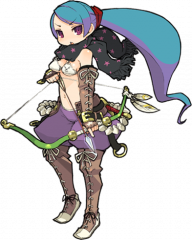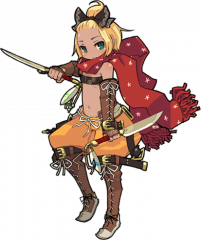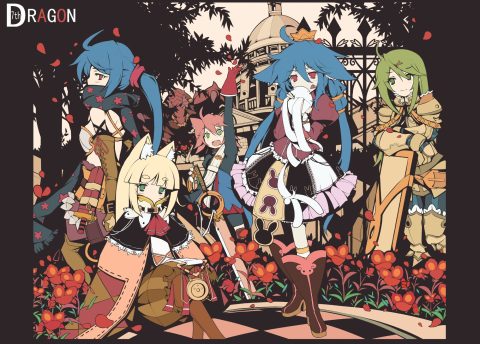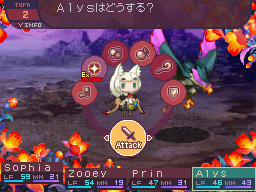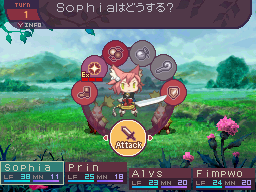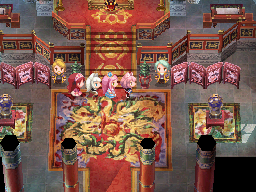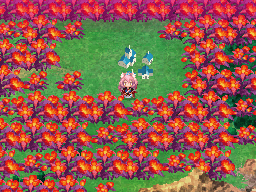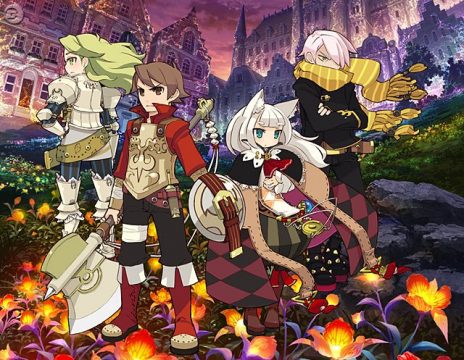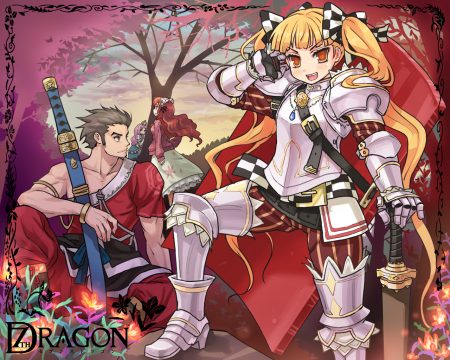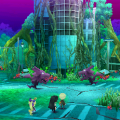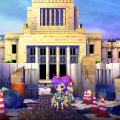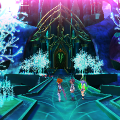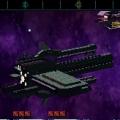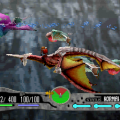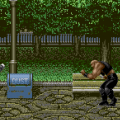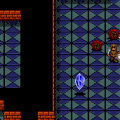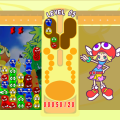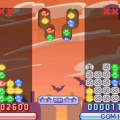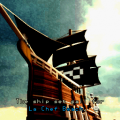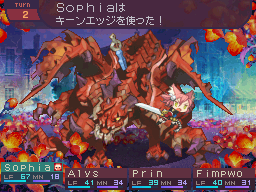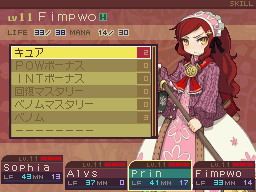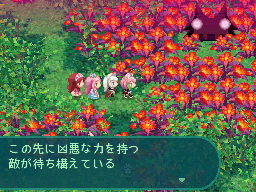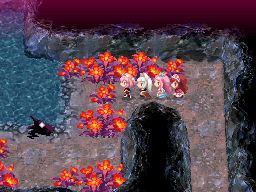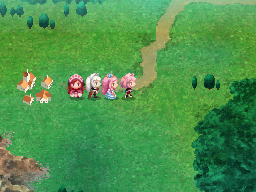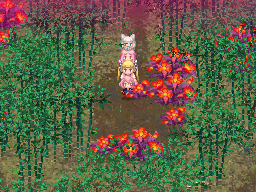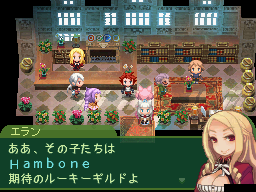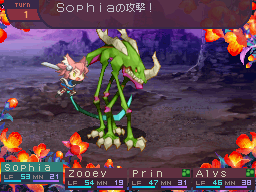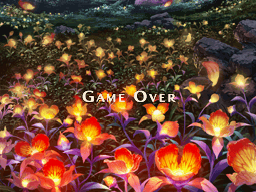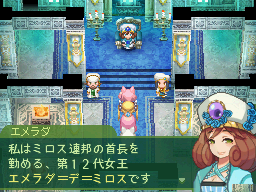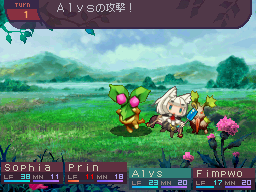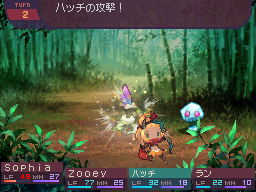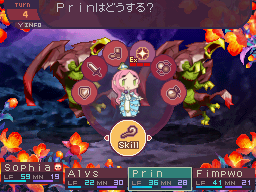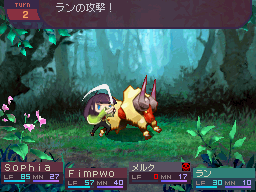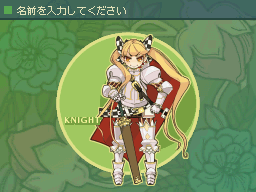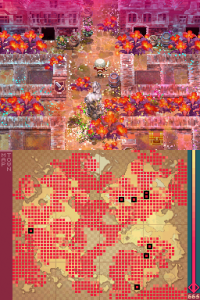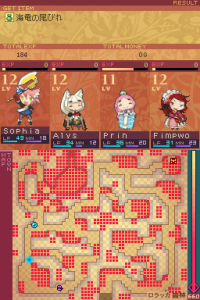Although the first person dungeon crawler was an immensely popular genre in the 80s, with titles like Wizardry, The Bard’s Tale, and Might & Magic, it soon fell out of popularity, with many moving into full 3D, and latecomers like Stonekeep failing to impress much of anyone, as the RPG moved to isometric games like Baldur’s Gate and Diablo. It continued to maintain a bit more popularity in Japan with Atlus’ Shin Megami Tensei series, but even those began to change, first with the spinoff title Persona 2, and finalized with Shin Megami Tensei III: Nocturne for the PS2.
Someone at Atlus, however, must have missed these types of games, and thus birthed Etrian Odyssey for the Nintendo DS, a tribute to 80s first person dungeon crawlers, featuring an intensely detailed character upgrade system, a mapping function handled via the touch screen, and cutesy character designs to appeal to the modern Japanese gamer. It proved to be a relative success, bringing back old hardcore fans and introducing a new generation of fans, awakening within them an affection they probably didn’t know they had. A few other niche titles, like The Dark Spireand Class of Heroes (itself a Wizardry spinoff) followed in its footsteps, with Atlus eventually bringing Shin Megami Tensei back to its first person roots with Strange Journey.
And yet, for all of the improvements that all of these games made to the age-old formula, there’s still a segment of the role playing population that will never, ever enjoy first person dungeon crawlers, no matter how they’re presented. In hope to capture that market, 7th Dragon (not to be confused with the lousy browser based MMORPG Seventh Dragon) was born, an unabashed mixture of Etrian Odyssey‘s mechanics set in the framework of Dragon Quest III. Developed by imageepoch, the same folks behind other DS RPGs like Luminous Arc and Sands of Destruction, it was directed by Kazuya Ninou, the original man behind Etrian Odyssey who had defected from Atlus during the development of the second game. It was published by Sega, and produced by Rieko Kodama, which should send fanboy shivers down the spine of anyone who’s played Phantasy Star or Skies of Arcadia.
7th Dragon opens the same way as Etrian Odyssey, letting you name your guild, and allowing you to create and name your party. There are a total of seven classes, many of which are similar to classes in the first Etrian Odyssey, although some of the skills have been shuffled about. The prime difference is that you can only have four people in the party at a time rather than five. Although technically you have to name the characters, each design has their own “canon” name, which can be activated by inputting a password as their name, which can be obtained from the Japanese 7th Dragonweb site. This also grants them one additional skill point.
Character Classes
Fighter
Male: Boon, Leo – Female: Moiko, Harukara
The main offensive class, naturally, the fighter’s main weapons include swords and axes. Axes do more singular damage but swords have a skill which can hit multiple enemies. Also useful is the Double Attack skill, which will randomly execute an additional attack, and Offensive and Defensive Switches, various stances to improve either skill. They are basically Landsknechts, in Etrian Odyssey terms.
Knight
Male: Ares, Grion – Female: Kate, Berich
The Knights acts as tanks, with a number of defense and shield skills to decrease damage to other party members, or absorb attacks directed at compatriots near death. They also have a small number of healing and attack spells, as well as the Walk Safe skill, which reduces the damage taken on the field and in dungeons by the poisonous flowers. She can also use the “Save the Queen” attack if a Princess has targeted an enemy with the Princess Order skill. The equivalent to the Protector class from Etrian Odyssey.
Samurai
Male: Shishimaru, Gassan – Female: Ran, Namuna
Samurais are variations on Fighters, basically like Ronins, being able to utilize Katanas rather than typical swords. They have three different stances – Zamba, Iai, and Unarmed – each with various skills, the third of which include a number of powerful counterattacks. Their Demonic Countenance skill can also be used, like the Flutes, to reduce the rate of random encounters.
Mage
Male: Sharuru, Glast – Female: Ikarakun, Vanessa
The usual magician class, parallel to the Alchemist in Etrian Odyssey, the Mage can learn a number of Fire, Ice, Lightning, Mana (non-elemental), and “Space” based spells, the last of which is used for teleportation and other abilities. They can also improve the use of healing restoratives and increase the rate of random drops.
Healer
Male: Kevin, Jericho – Female: Mol, Rosary
The Healer, obviously, has access to all of the healing spells, as well as a number of skills to poison enemies. Additional skills include increasing critical hit rates, preventing surprise attacks, and reducing random encounter rates. Since harvesting isn’t as important as it is in Etrian Odyssey, there’s only one Harvesting skill, and it’s bestowed upon these guys.
Princess
Male: Yac, Eustis – Female: Melk, Hatch
Rogues are similar to Survivalists, in that they have extremely high speeds, and use bows. However, they have no harvesting skills, the sole one having been given to the Healer. They can also wield daggers, and have a curious skill that can cause extreme damage to all enemies, but sacrifices their own life permanently.
 The character designs are handled by an artist known as mota, and actually manage to out-cute the cast from Etrian Odyssey. There are four designs for each class – two male and two female (except for the princess) – and one each is a Lucier, a human-like race with pointy cat-like ears. It’s very hard to create a party that isn’t ridiculously adorable.
The character designs are handled by an artist known as mota, and actually manage to out-cute the cast from Etrian Odyssey. There are four designs for each class – two male and two female (except for the princess) – and one each is a Lucier, a human-like race with pointy cat-like ears. It’s very hard to create a party that isn’t ridiculously adorable.
Once you’ve gotten everything in gear, you’re free to roam around town, leave to the world map and explore dungeons. These all look and feel like the DS Dragon Quest remakes, complete with 2D sprite characters, all four party members walking in a line, on top of 3D backgrounds. The bottom screen displays a map – the overworld is always visible, although you need to find a map to view the layout of the dungeons. The map making stuff from Etrian Odyssey is completely gone.
Once again keeping with Etrian Odyssey, the soundtrack is composed by Yuzo Koshiro. Rather than adhering with the classic PC98 FM synth sound, 7th Dragon‘s music is a bit more of a traditional RPG soundtrack, filled with an eclectic mix of genres. The battle theme is a remarkably catchy piece, strangely warm and fuzzy, only straddled by the fact that it’s far too long – the battles go by so quickly that you’ll rarely here anything beyond ten second long intro. The world map and dragon fight themes hail from Dragon Quest, while the dungeon and town themes could be from any SNES-era RPG. It’s all great stuff. The official soundtrack contains four CDs, two of the DS music, and two of rearranged music rendered in NES-style chiptunes. Some of these alternate renditions are vastly different, but all are quite good. (They can unlocked in game by beating the game and obtaining the 8-bit Ronam item in the Beautiful Heimel dungeon. It can then be enabled in the Options menu.)
In towns, you can take on Quests, which are (usually) optional adventures to take on a specific task, or Missions, which are required to carry on the storyline. Your characters have no real speaking roles, but the world is filled with interesting NPCs, many of the most important ones having their own character portraits. The plot itself is minimal – rid the world of Eden from attacking dragons – and while the individual scenarios aren’t quite as involving as Dragon Quest, there’s enough interesting to flesh out the game world, even though it is pretty generic. At any rate, the story is really only there to support 7th Dragon‘s true purpose – the exploration and the fighting.
The fights are fairly standard first person battles, albeit with a bit more flash. Etrian Odyssey was pretty weird, in that it went through all of the trouble to design dozens of attractive character designs, but since the entire game was viewed in the first person, you only ever saw them in menus. In addition to the third person perspective in the field, your characters will appear in fight scenes, taking a stoic pose center stage when picking commands, and appearing for a split second when executing attacks. While not fundamentally different from either Dragon Quest or Etrian Odyssey, it helps flesh out your party’s personality, and is also much more visually engaging. None of this bogs down the speed either – battles are still remarkably quick, and turns blaze past when holding down the A button.
The actual battle system is a pretty standard turn-based affair, with one notable twist – the Exhaust system. These charges, called EX on the menu, can be summoned to drastically improve the strength of the next action – for example, increasing your attack strength, the potency of a status effect spell, or the amount of HP healed. However, these charges can only be used three times per character, before they need to be recharged at an inn. Also, amongst the usual offensive and buffing moves, there are also a handful of “Synergy” skills, where having two different classes executing two different skills can cause them to work together. Additionally, there are “React” skills which, when certain conditions are met, can grant you an extra turn.
The first few hours of the game act as a prologue before the story begins proper. Here, the world becomes infested with poisonous flowers called Furowaro (known as Dragonsbane in the English localization of 7th Dragon III). Stepping on these will drop each of your party member’s health by 2%, but will trample the flower in the process. These things are, literally, everywhere – the world map will show practically the whole planet is flooded with them. When you’re on the world map, stepping them will cause them to disappear, which is very important to note. The local economy is affected by the presence of the Furowaro, so clearing the surrounding area of each town is essential to bring down the price of goods. However, in dungeons, they’re remarkably persistent, and will reappear as soon as you leave the screen. And since the dungeons consist of narrow corridors, there’s often no way to avoid them. At least once you beat the boss of the dungeon, the whole area will be permanently cleared of Furowaro, allowing you to explore further for additional treasures.
While the Furowaro lend to the harrowing atmosphere, they’re really more annoying than anything else. In keeping with the old school RPG tradition, 7th Dragon is all about grinding and resource management, as you delve through dungeons, exploring and battling until you run out of health and magic, then retreating and trying again. Random battles are constant, and it’s hard to go more than a few steps without being sucked into combat. It is, very much consciously, a time sink. But the Furowaro feels like an extra artificial barrier, making things even worse as they constantly drop your health and force you to waste restorative items. It also creates a haphazard sense of balance, and lots of difficulty spikes. You can explore a dungeon where you can technically trounce any of its enemies without much of a thought, but still end up limping around. And while the Knight has a skill to reduce damage, and items can be found to the same effect later in the game, they really don’t help enough. To be fair, most dungeons have a restorative point that will completely heal your party and can be used an unlimited amount of times. However, these won’t replenish EX charges, so you still need to conserve them, and save points are still mostly limited to inns and other spots on the world map.
In addition to random battles, the dungeons are filled with dragons visibly flying through the corridors. On the right side of bottom screen is a meter that shows how many dragons are flying around the world of Eden. It starts at 666, and over the course of the game, goes down as you defeat each dragon, one by one. (Expect this to take a long time – there’s easily 60 or more hours of gameplay to be had.) In essence, these are very similar to the FOEs from Etrian Odyssey. However, while FOEs were extremely powerful creatures to be feared and avoided whenever possible, the dragons here are more like mid-bosses – they’re generally more powerful than the standard groups of enemies, but nowhere near boss levels. But, like FOEs, they can interrupt any random battle if they’re close enough. Dragons will appear on the map (provided you’ve found the applicable item for that dungeon), and numbers will appear next to them, denoting how many turns before they’ll barge into the scene. Therefore, it’s important to learn to defeat random battles quickly, just so you have time to heal between battles and aren’t caught with your pants down. The upside of the dragons appearing on the map is that you can sneak up on them behind and ambush them, giving you an extra turn.
There’s a lot of stuff 7th Dragon does fantastically, and it’s a fine antidote towards the linear, stripped down, cutscene driven modern RPGs. But while it looks like Dragon Quest, it doesn’t feel like Dragon Quest – it’s much more intense, focusing less on atmosphere and more on character building. It really is like an alternate version of Etrian Odyssey, but frustratingly enough, it manages to carry over most of its issues wholesale.
For starters, the Quest structure is somewhat awkward. First, you need to talk to a specific person to unlock the Quest. Then, you need to return to a guild hall to accept it. Then you usually need to find someone to gain explicit orders. Once you’ve completed it, you return to the person who instructed you, then returned to the guild. Furthermore, there’s no way to track which Quests you’ve accepted without visiting the Guild, and even then, your instructions are vague. It’s very possible to lose your bearings if you step away from the game and return, having forgotten everything in the process. A more fluid method of handling side quests has existed for years – why jump through all of these hoops?
The character customization is too freeform and too unbalanced. Each character has about thirty different skills, each of which can be upgraded multiple levels. You start off with three skill points (SP) to distribute, gain one for most level gains, and gain two every five levels. These include stat bonuses, allowing you to raise your power, intellect or speed, as well as your skill with various types of weapons, but also special attacks and magical abilities. There are only a handful of skills open at the beginning, but as you level up certain abilities, you’ll open up new ones. These skill trees are vaguely illustrated on the bottom screen, although this isn’t too much help, because you’ll be wanting to use a FAQ anyway.
This is because there are very specific ways to build characters, and unless you know the proper skills ahead of time, you can potentially create yourself a character that’s worthless and make things more difficult for yourself. Not all of the skills are all that useful, or only become useful if they’re leveled up sufficiently, making you feel like you’ve wasted your hard earned skill points. Aspects like these discourage diversifying. You can, technically, make new characters from scratch at any point in the game, or use items to strip characters of their skills, but both of these require a lot of time investment to build or rebuild their experience levels. There is no multi-classing either, seeing how the characters’ ability trees are completely set in stone. This feels strange when compared to Dragon Quest III, which allowed you to mix and match classes partway through the game. It’s another aspect where 7th Dragon feels so tethered to its primary source.
That’s really the issue with 7th Dragon – at no point does it feel like its own game, so much as a bastard child. That doesn’t actually make it a bad game in any regards though – it’s infinitely more approachable than Etrian Odyssey, and more than nicely fulfills its own niche in JRPG-dom.
It is rather unfortunate that Sega decided to not localize 7th Dragon into English, instead passing it over for dreck like Sands of Destruction. The general response from other North American publishers is that the game is too challenging – it’s not easy but it’s certainly less difficult than Etrian Odyssey. Thankfully, in 2014 the game was fan translated by Cavespeak, which also includes an easy mode patch which reduces the encounter rate and Furowaro damage.
